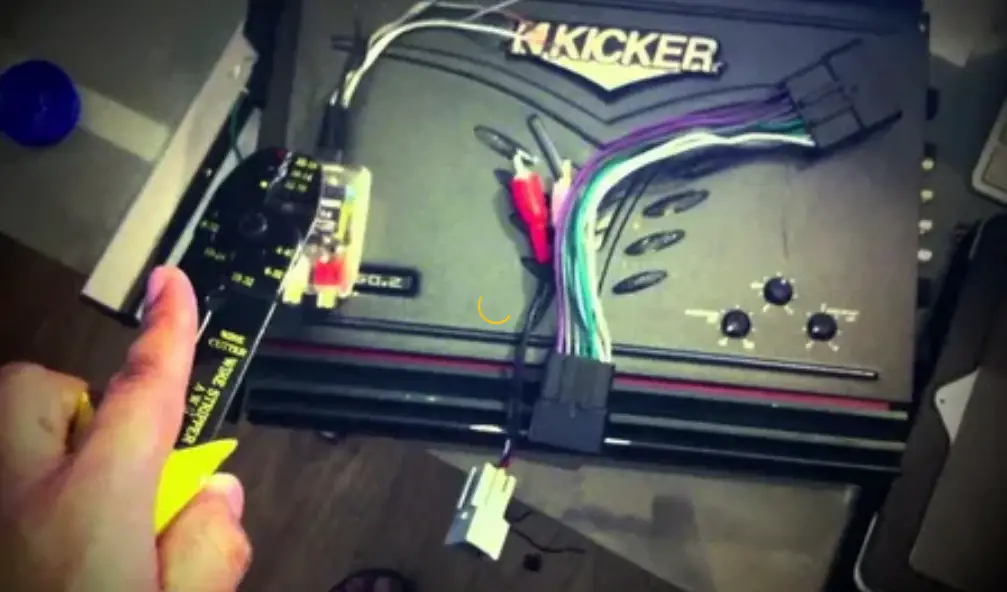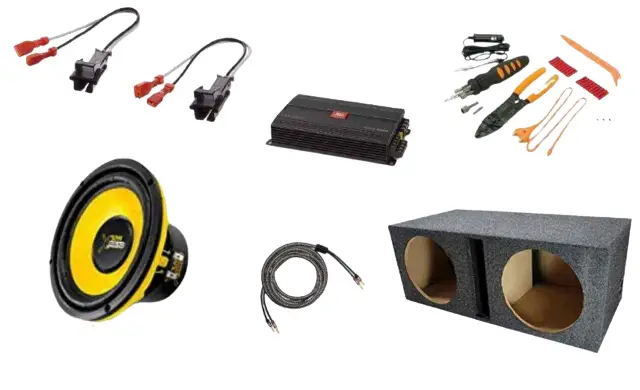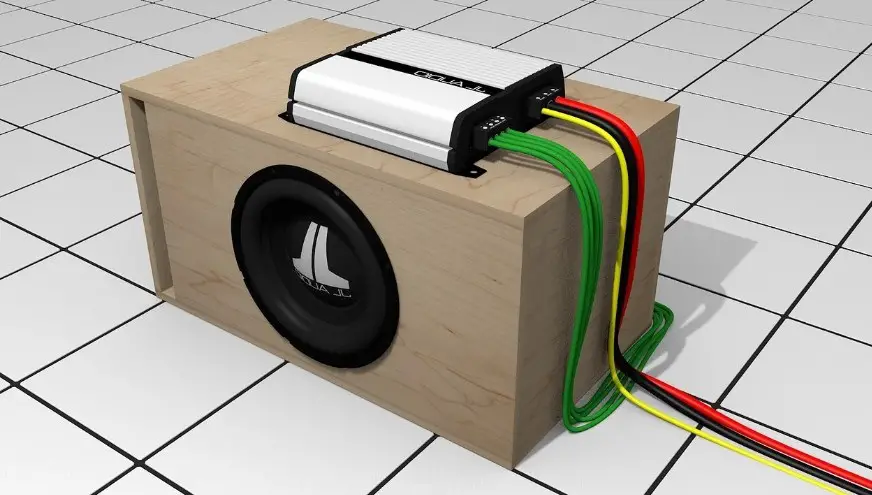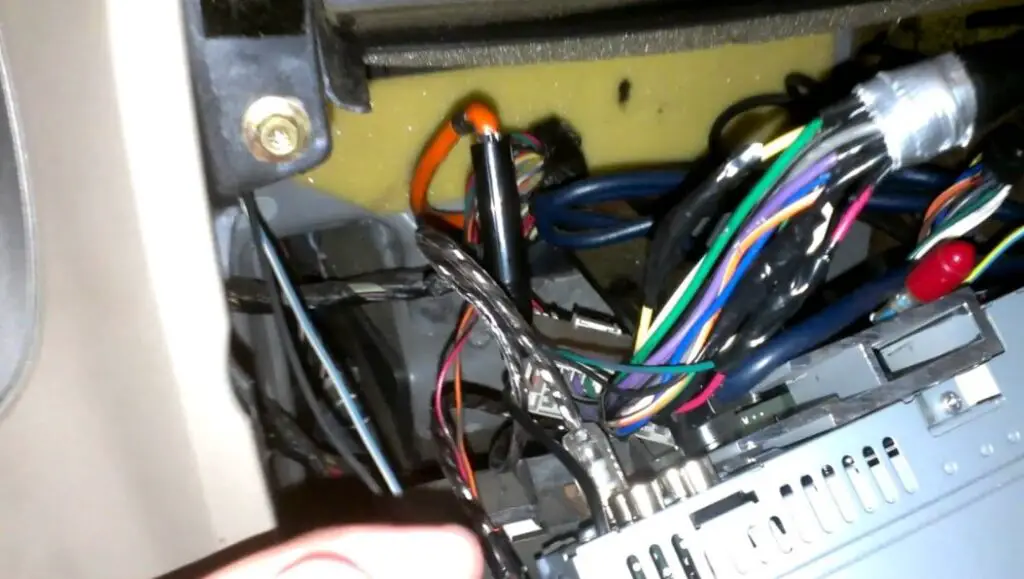If you already have a great infotainment system from the factory but want to further improve your in-car audio quality, adding a subwoofer might be the perfect option. This will add some much-needed depth to your sound system. You can connect an aftermarket subwoofer to a factory radio, but this will require a few extra steps compared to connecting to the stereo speaker outputs.
The first thing you will need to purchase in addition to your new subwoofer is a monobloc amp. This is what you need to provide the subwoofer with enough power to do its job.

You will also need an amp kit to supply power from the car battery to the amplifier itself. This kit includes everything you require including wires such as RCA cables, speaker wires, and remote control wires. In this article, we’ll dive into the details of how to install a subwoofer in your factory stereo. Let’s go through the full process.
How do you hook up a sub amp to a factory radio?
The steps to add a subwoofer to your factory stereo are fairly easy to follow. There is no need to worry. You should be fine if you just follow it.
Step 1: Collect materials
First, you must collect all the tools and equipment that you will need to complete the process. Take a look at them through the following list.
- Basic tool kit containing screws, screwdrivers, wrenches, pliers, tape, knives, sockets, and hammers.
- Subwoofer box for subwoofer placement.
- Factory amp.
- RCA cables.
- Wiring materials.
- Line output converter.
- The built-in fuse of at least 50 amps.
- Protective equipment such as gloves, goggles, and/or masks.

Depending on your individual system and requirements, you may need some other materials, so in this case, proceed at your own discretion or seek the help of a professional. You can also use alternatives to some of the above tools if they fit the system well.
Step 2: Choose your speaker and amplifier
A speaker or amp may run at full power for about a minute before it burns out or overheats. You must consider the RMS rating of your subwoofers, not the peak rating.
Step 3: Disconnect the battery connection
When working with any electrical items, you must first make sure everything is unplugged. So, turn off the car, remove the keys and open the hood to access the car battery. Once you see the battery, carefully select the vehicle’s negative battery terminal. This is usually the black cable. Disconnect it from the battery to avoid short circuits or damage to the factory stereo.
Our safety experts recommend the use of rubberized gloves throughout the process to minimize electrical shock.
Step 4: Disconnect speaker wires
Just unplug your vehicle’s main power supply and turn it off, then physically disconnect the wires from the appropriate ports or terminals.
Step 5: Place the subwoofer
The first step you will need to take is to properly position the subwoofer in the car audio. Make sure you find a suitable place for this inside the car, as it is important to provide enough space for the device.
You don’t want the subwoofer to be too cramped, as this can easily cause it to overheat due to the presence of the amp. As long as you find a spot that can dissipate heat and provide enough breathing room, your subwoofer will perform well. Make sure you also have easy access to the subwoofer when you need to adjust, clean, or repair it.
The wires and cables must also be easily connected to the various parts of the system so that you don’t have to deal with any voltage; otherwise, it can create problems preventing the subwoofer from working properly.
Step 6: Take precautions
You must ensure that you have taken the necessary precautions before you begin the wiring and connection process so that you can add a car subwoofer to your stock stereo. These precautions can help you avoid accidents or damage during the process.
Otherwise, these accidents may damage the sound system, and other vehicle components, and cause injury due to bumps and hazards.
You don’t need to disconnect the entire battery, but make sure you disconnect the negative terminal from the battery.
You can then set that negative terminal wire aside, making sure it doesn’t make too much contact with any other parts of the car or vehicle. Before handling any wires or cables, make sure you put on all protective equipment to avoid direct contact with the materials. If there is moisture around the parts, let them dry.
Step 7: Install the power wire
Now check the cables and ports of your car factory stereo. Locate the RCA cables and remove the outputs along with the power wire. However, you will also have to reconnect the RCA cable signal cables to the RCA inputs in order to reinstall your stock car factory stereo. Next, connect the battery power wire to the car subwoofer.
Since the power wire will run from the engine compartment to the main interior of the car, it is very important to organize the wiring connections. For better organization and aesthetics, hide cables under car floor mats or under trim panels. This will hide the cables and protect them from being pulled and pulled by the people in the car.
You also need to check the amplifier wiring kit. Sometimes the fuse box is ready, but if not, you will also have to prepare it. Start by cutting a short section of the power wire. Remember that the length must be sufficient to cover the distance from the location of the fuse holder to the position of the battery.
Once the length is sufficient, strip the insulation from both ends to crimp the terminal rings on one end and attach the fuse holder on the other. Remember that placing a fuse box near the battery helps prevent short circuits, especially since the wire between the terminal and the fuse is exposed.
Step 8: Check the subwoofer cables
First of all, check if the RCA cable and turn-on wire are connected to the car factory stereo. These wires must run on the opposite side of the vehicle, away from the power wire. This is necessary to reduce any possible electrical interference.
The RCA signal cables must be connected to their RCA outputs, and the remote turn-on wire, usually seen as the blue wire, must be connected to the factory stereo wiring harness. However, for those who don’t use an aftermarket stereo, this is an inconvenient package as the preamp outputs are usually unequipped.
These factory stereos need a line output converter to convert amplified high-level signals to RCA preamp-level signals.
If a line output converter is not available, you can branch the speaker wire behind the factory stereo or rear car speakers. This is necessary to feed the signal to the built-in amplifier of the active subwoofer.
Step 9: Determine the appropriate connections
Once all output ports have been set, look for any connections that may be important to this connection process. Connect the LFE jack on the receiver and the output port on the subwoofer cabinet. Simply plug the connector into the port using the hole provided.
Step 10: Lay the wires
Start by connecting the battery. Find a hole in the car’s firewall. Run most of the power wire through the hole in the firewall, leaving enough wire to reach the battery. At the end of the wire where the battery is located, remove the insulation.
Then connect the built-in fuse to this terminal. Pass the remaining wire under the car carpet or through the wire channel, if available. You need to run this wire to the trunk.
Step 11: Use a converter
You will need a line output converter if you have a head unit in your car. This is because the factory head unit usually has speaker wires but no preamp output that can convert them to RCA signals. These line output converters can make it very convenient for you to connect your factory stereo to your amplifier and subwoofer.
Make sure you connect the speaker wires correctly to make the conversion process easier.
Step 12: Strengthen your connections
The next step is to strengthen the connections by connecting the positive wires from the subwoofer to the left speaker marked (+). Connect the negative wires from the auxiliary unit to the left speaker marked (-).
Step 13: Connect the power cables to the subwoofer
The ground wire is the third main connection of the system. It is very important that your active subwoofer is grounded to good ground. To do this, use a bolt to connect the ground wire to the vehicle’s chassis. The ground wire terminal must be in contact with bare metal on the vehicle.
To make sure the ground cable is grounded, use sandpaper to remove all paint and other debris. Now connect the power cable to the negative battery terminal. This is the negative terminal from which you disconnected the black cable before starting the process.
Remember to handle the wire properly so that it produces power output.

Can you hook up subwoofers to a stock stereo?
- Step 1: Disconnect the battery. To protect yourself and your equipment during installation, it goes without saying that you must disconnect the negative battery terminal before starting any electrical work.
- Step 2: Connect the power wires together. The battery power connection to the active subwoofer must go through the firewall separating the engine compartment from the rest of the cabin.
- Step 3: Connect the power cords and signal cables. Then lay the power and signal lines. You will need to use a line-out converter because most OEM stereos don’t have preamp outputs.
- Step 4: Attach the ground wire. A bolt must be used to attach the ground wire to the vehicle chassis. Bare metal should be in contact with the ground wire.
- Step 5: Connect the wiring. The negative terminal of your vehicle’s battery must be reconnected. However, before testing a powered subwoofer, make sure the built-in amplifier gain is turned off. If you carefully follow these steps, you will get an answer on how to install a subwoofer on factory radio.
Safety tips and reminders
When installing a subwoofer on a head unit, some precautions must be observed.
- Use insulating gloves. This means that your hands are protected from any electrical surges. This also ensures that you will not be electrocuted if accidents occur during installation.
- Stay away from water. Since you will be dealing with wires and electricity, our health and safety experts advise you to stay away from water sources. Water is an excellent conductor of electricity and will not only damage your powered subwoofers. In addition, it may cause electric shock.
- Don’t forget to install the ground wire. While electronic devices will still work without ground cables as long as all components are present, the presence of a ground wire provides greater protection against fire and overheating.
Can I add speakers to stock radio?
There are two ways to add a subwoofer to a standard stock stereo system.
- Hi-Low Converter. It’s just a little converter that plugs into your speaker wires and has RCA inputs. The main problem is that you won’t get true sound quality from your subwoofers.
- Line output converter. The Line Out converter is similar to the Hi-Low converter but on a much larger scale. It just means you get fantastic sound while keeping your existing factory stereo system and controls.
Should I add a subwoofer to the factory amplifier?
Many people like to upgrade the stereo system in their cars. One popular upgrade is the addition of a subwoofer to the factory stereo. A subwoofer is a large speaker that reproduces low-frequency sounds.
These low frequencies can add more depth and power to your music. Adding a subwoofer to your factory stereo can be a relatively simple process. The first step is to figure out what factory system you have. Knowing this, you can purchase a subwoofer that is compatible with your system.
You will then need to get the speaker wire signal from the factory stereo and connect it to the car battery. Finally, you will need to connect your wired speaker signal to the RCA input on the subwoofer. By following these simple steps, you can easily add a subwoofer to your factory stereo and enjoy an improved sound system in your car.
Most factory stereos are designed to provide an all-around listening experience, but they often fail to handle the bass system. This is where a subwoofer comes in. A subwoofer is a type of speaker that specializes in reproducing low frequencies, giving your music a deeper and more powerful sound.
In addition, a subwoofer can help improve the overall sound quality of your stereo by providing a stronger base for other rear deck speakers to work on. While installing a subwoofer may seem like a daunting task, it’s actually quite simple.
In most cases, all you need is a few basic tools and some basic knowledge of a car audio system. With a little effort, you can greatly improve the sound of your factory stereo.
Frequently Asked Questions
Can component speakers be connected without amplifiers?
It connects, and there are no minuses here, as well as pluses. The speaker reproduces sound like stock speakers. However, component acoustics is a rather tangible financial investment; it makes no sense to use it without an amplifier.

What will be the optimal power of auto acoustics?
Experts recommend buying amplifiers, the power of which is 1.6 times the power of the speakers. The fact is that the formation of sound quality occurs when the speaker is at 90% and the amplifiers are at 60% of the rated power. If there is not enough power, there will be a “clipping” effect, due to which the speaker is disabled.
For example, if you need an amplifier for a subwoofer with a nominal value of 350 W, then you should pay attention to 400-watt monoblocks. If you buy an amplifier with less power, then at high volume the subwoofer will produce crackling and distortion.
The power of the subwoofer should exceed that of the speakers by 2-4 times. You should also take into account the resistance: a smaller subwoofer sounds louder, with a larger one – better. If we talk about the choice of amplifiers for acoustics, then the situation is a little different. 50W speakers actually run at 15-20W, so a 4×50W amplifier will suffice for them.
When choosing a speaker, you should pay attention to three indicators:
- Frequency range.
- Sensitivity.
- Power.
The maximum volume will depend on the power, but sometimes you can sacrifice it for the sake of high sensitivity. Power and sound quality will only benefit from this.
Conclusion
Now that you’ve learned the process of installing an active subwoofer on your factory stereo, you can now do it yourself with confidence. Just follow the step-by-step instructions, and don’t forget to stay out of the water and use insulating gloves to protect yourself.
Read also: Which Icom antenna tuner would be the best if you wanted to set up a long wire in a tree?
